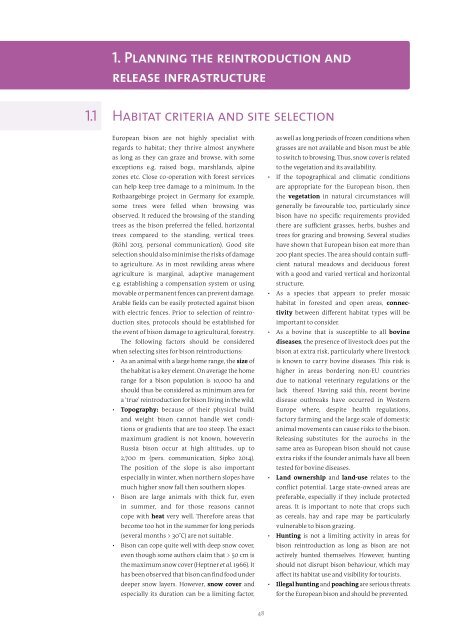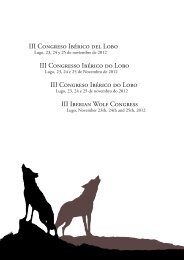Bison-Rewilding-Plan-2014
Bison-Rewilding-Plan-2014
Bison-Rewilding-Plan-2014
- No tags were found...
You also want an ePaper? Increase the reach of your titles
YUMPU automatically turns print PDFs into web optimized ePapers that Google loves.
1. <strong>Plan</strong>ning the reintroduction andrelease infrastructure1.1Habitat criteria and site selectionEuropean bison are not highly specialist withregards to habitat; they thrive almost anywhereas long as they can graze and browse, with someexceptions e.g. raised bogs, marshlands, alpinezones etc. Close co-operation with forest servicescan help keep tree damage to a minimum. In theRothaargebirge project in Germany for example,some trees were felled when browsing wasobserved. It reduced the browsing of the standingtrees as the bison preferred the felled, horizontaltrees compared to the standing, vertical trees.(Röhl 2013, personal communication). Good siteselection should also minimise the risks of damageto agriculture. As in most rewilding areas whereagriculture is marginal, adaptive managemente.g. establishing a compensation system or usingmovable or permanent fences can prevent damage.Arable fields can be easily protected against bisonwith electric fences. Prior to selection of reintroductionsites, protocols should be established forthe event of bison damage to agricultural, forestry.The following factors should be consideredwhen selecting sites for bison reintroductions:• As an animal with a large home range, the size ofthe habitat is a key element. On average the homerange for a bison population is 10,000 ha andshould thus be considered as minimum area fora ‘true’ reintroduction for bison living in the wild.• Topography: because of their physical buildand weight bison cannot handle wet conditionsor gradients that are too steep. The exactmaximum gradient is not known, howeverinRussia bison occur at high altitudes, up to2,700 m (pers. communication, Sipko <strong>2014</strong>).The position of the slope is also importantespecially in winter, when northern slopes havemuch higher snow fall then southern slopes.• <strong>Bison</strong> are large animals with thick fur, evenin summer, and for those reasons cannotcope with heat very well. Therefore areas thatbecome too hot in the summer for long periods(several months > 30˚C) are not suitable.• <strong>Bison</strong> can cope quite well with deep snow cover,even though some authors claim that > 50 cm isthe maximum snow cover (Heptner et al. 1966). Ithas been observed that bison can find food underdeeper snow layers. However, snow cover andespecially its duration can be a limiting factor,as well as long periods of frozen conditions whengrasses are not available and bison must be ableto switch to browsing. Thus, snow cover is relatedto the vegetation and its availability.• If the topographical and climatic conditionsare appropriate for the European bison, thenthe vegetation in natural circumstances willgenerally be favourable too, particularly sincebison have no specific requirements providedthere are sufficient grasses, herbs, bushes andtrees for grazing and browsing. Several studieshave shown that European bison eat more than200 plant species. The area should contain sufficientnatural meadows and deciduous forestwith a good and varied vertical and horizontalstructure.• As a species that appears to prefer mosaichabitat in forested and open areas, connectivitybetween different habitat types will beimportant to consider.• As a bovine that is susceptible to all bovinediseases, the presence of livestock does put thebison at extra risk, particularly where livestockis known to carry bovine diseases. This risk ishigher in areas bordering non-EU countriesdue to national veterinary regulations or thelack thereof. Having said this, recent bovinedisease outbreaks have occurred in WesternEurope where, despite health regulations,factory farming and the large scale of domesticanimal movements can cause risks to the bison.Releasing substitutes for the aurochs in thesame area as European bison should not causeextra risks if the founder animals have all beentested for bovine diseases.• Land ownership and land-use relates to theconflict potential. Large state-owned areas arepreferable, especially if they include protectedareas. It is important to note that crops suchas cereals, hay and rape may be particularlyvulnerable to bison grazing.• Hunting is not a limiting activity in areas forbison reintroduction as long as bison are notactively hunted themselves. However, huntingshould not disrupt bison behaviour, which mayaffect its habitat use and visibility for tourists.• Illegal hunting and poaching are serious threatsfor the European bison and should be prevented.48



